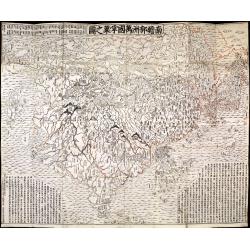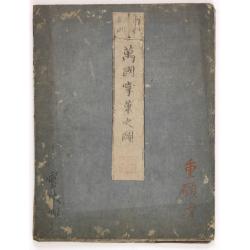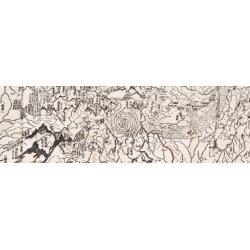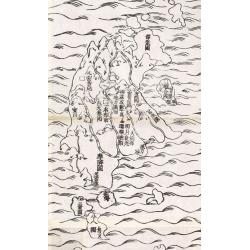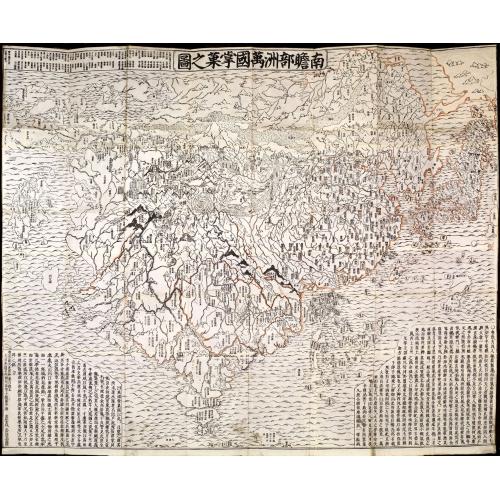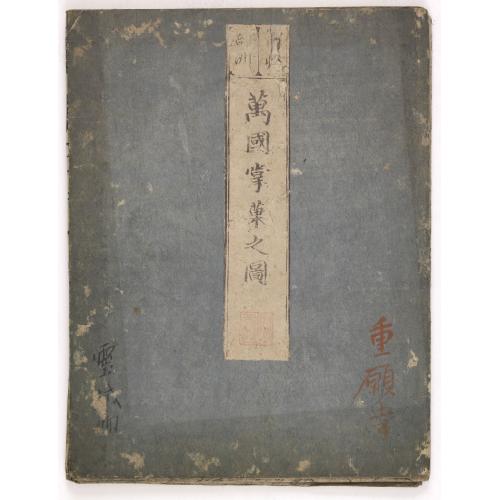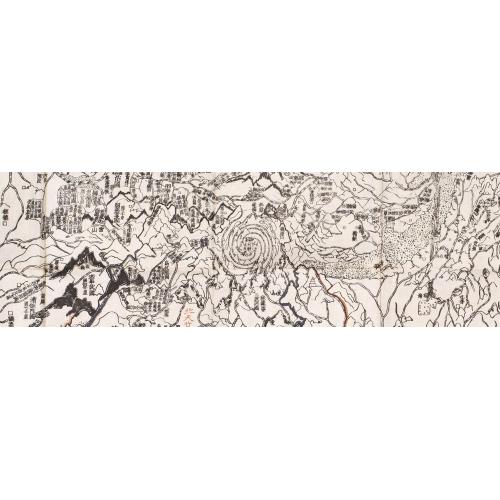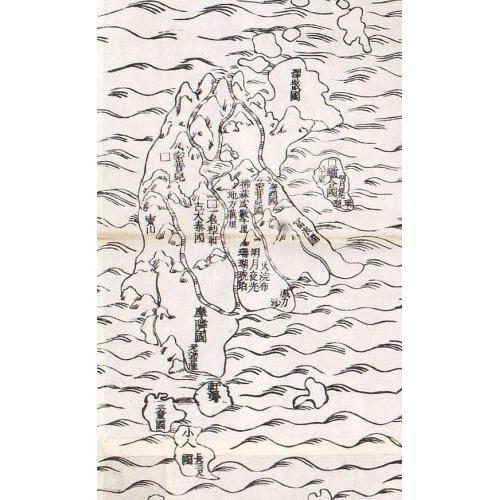Description
This wall-map is a great example of Japanese world maps representing Buddhist cosmology with real-world cartography. It is the earliest one and - therefore - the prototype for Buddhist world maps.
They all represent a large, imaginary India, where Buddha was born, as the heart of the world, but also depictions of Europe and the New World.
At the time, Japan maintained an isolationist policy that began in 1603 with the Edo period under the military ruler Tokugawa Ieyasu and lasted for nearly 270 years. Although knowing the world map by Matteo Ricci, published in Peking in 1602, Japanese maps mainly showed a purely Sino-centric view - or with acknowledgment of Buddhist traditional teaching - the Buddhist habitable world with an identifiable Indian sub-continent.
The map was drawn by the scholar-priest Zuda Rokashi, founder of Kegonji Temple in Kyoto, and illustrates the fusion of existing Buddhist and poorly known European cartography. The language is Chinese, except for a few Japanese characters on the illustrations of European countries.
Europe is shown at the upper left as a group of islands, identified from Iceland to England, Scandinavia, Poland, Hungary, and Turkey, but deliberately deleting the Iberian Peninsula. At the lower right, South America is featured as an island south of Japan with a small peninsula as part of Central America, carrying among just a few place-names also 4 Chinese characters whose phonetical Japanese reading is "A-ME-RI-KA." North of Japan, a land bridge joints Asia with an unnamed landmass, presumably North America. Africa is not shown at all.
On the other hand, this map is much more than a world map, and the main concept by the author was to celebrate a historically very important event. The map echoes the pilgrimage route of the famous Chinese Buddhist priest Hsuan-Tsang (or Xuan Zhuang, Genjo in Japanese, 602-664 A.D.), who traveled to India to visit sacred places of Buddhism and also to collect holy Sanskrit writings. So the largest part of the map is depicted as "Jambu-Dvipa" with the sacred Lake of Anavatapta (Lake Manasarovar in the Himalayas) at the center, from which the 4 rivers Ganges, Oxus, Indus, and Tarim, are flowing. This all was based on the Japanese version of Hsuan-Tsang's Chinese narrative, the Si-yu-ki, printed as late as 1653. Here, numerous details are given, including the interesting feature of the so-called "iron-gate," shown as a strongly oversized square, and the path taken by the monk whilst crossing the forbidden mountain systems after leaving Samarkand. Also, in the upper left corner, 102 references from Buddhist holy writings and Chinese annals are mentioned to increase the map's credibility. Folded as usual and mounted on 2 blue cardboards with title-piece (size: 240x180mm, slightly spotted and scraped).
The first Buddhist world map printed in Japan served as the prototype for all subsequent maps until the late nineteenth century. The author, Hotan (1654-1728), was a scholar-priest and founder of the Kegonji Temple in Kyoto. The earliest known example in Japan is the Gotenjiku Zu (Map of the Five Indies) by the priest Jukai dating from 1364 and now preserved in Horyuji Temple in Nara. However, Hotan’s map was revolutionary as the first printed Oriental map to introduce detailed Western cartographic information into the traditional Buddhist cosmological view, attempting to merge the two into a comprehensible form. Europe is depicted as a series of islands in the upper left of the image whilst South America is likewise another island in the lower right of the image. Africa is omitted completely. China and Japan are clearly defined in the upper right of the map. The popularity of the map is evidenced by the fact that although the map is dated 1710, it was reissued unchanged in numerous editions through to about 1815 and spawned innumerable copies and derivatives over the next 150 years. a rare and important cartographic work.
Folded as usual and mounted on 2 blue cardboards with title-piece. (size 240x180mm), in modern linen case.
Reference : K Yamashita, Japanese Maps of the Edo Period, pp.32-33 ill. Nanba, Old Maps in Japan ill. 8. K.Unno, Cartography in Japan, 1994, page. 346-477 and illustration 11.59. Cortazzi, Isle of Gold page 38 and col.ill. 48. Beans Coll. 1710.1. Kerlen 44, Muroga & Unno, “The Buddhist World Map in Japan”, in IM XVI (1962). Harley & Woodward, The History of Cartography, 2.2, pp.428ff and ill.. 11.59.
They all represent a large, imaginary India, where Buddha was born, as the heart of the world, but also depictions of Europe and the New World.
At the time, Japan maintained an isolationist policy that began in 1603 with the Edo period under the military ruler Tokugawa Ieyasu and lasted for nearly 270 years. Although knowing the world map by Matteo Ricci, published in Peking in 1602, Japanese maps mainly showed a purely Sino-centric view - or with acknowledgment of Buddhist traditional teaching - the Buddhist habitable world with an identifiable Indian sub-continent.
The map was drawn by the scholar-priest Zuda Rokashi, founder of Kegonji Temple in Kyoto, and illustrates the fusion of existing Buddhist and poorly known European cartography. The language is Chinese, except for a few Japanese characters on the illustrations of European countries.
Europe is shown at the upper left as a group of islands, identified from Iceland to England, Scandinavia, Poland, Hungary, and Turkey, but deliberately deleting the Iberian Peninsula. At the lower right, South America is featured as an island south of Japan with a small peninsula as part of Central America, carrying among just a few place-names also 4 Chinese characters whose phonetical Japanese reading is "A-ME-RI-KA." North of Japan, a land bridge joints Asia with an unnamed landmass, presumably North America. Africa is not shown at all.
Reference : K Yamashita, Japanese Maps of the Edo Period, pp.32-33 ill. Nanba, Old Maps in Japan ill. 8. K.Unno, Cartography in Japan, 1994, page. 346-477 and illustration 11.59. Cortazzi, Isle of Gold page 38 and col.ill. 48. Beans Coll. 1710.1. Kerlen 44, Muroga & Unno, “The Buddhist World Map in Japan”, in IM XVI (1962). Harley & Woodward, The History of Cartography, 2.2, pp.428ff and ill.. 11.59.
FAQ - Guarantee - Shipping
Buying in the BuyNow Gallery
This item is available for immediate purchase when a "Add to Cart" or "Inquire Now" button is shown.
Items are sold in the EU margin scheme
Payments are accepted in Euros or US Dollars.
Authenticity Guarantee
 We provide professional descriptions, condition report (based on 45 years experience in the map business)
We provide professional descriptions, condition report (based on 45 years experience in the map business)
Paulus Swaen warrants the authenticity of our items and a certificate of authenticity is provided for each acquired lot.
Condition and Coloring
We indicate the condition of each item and use our unnique HiBCoR grading system in which four key items determine a map's value: Historical Importance, Beauty, Condition/Coloring and Rarity.
Color Key
We offer many maps in their original black and white condition. We do not systematically color-up maps to make them more sellable to the general public or buyer.
Copper engraved or wood block maps are always hand colored. Maps were initially colored for aesthetic reasons and to improve readability. Nowadays, it is becoming a challenge to find maps in their original colors and are therefor more valuable.
We use the following color keys in our catalog:
Original colors; mean that the colors have been applied around the time the map was issued.
Original o/l colors; means the map has only the borders colored at the time of publication.
Colored; If the colors are applied recently or at the end of the 20th century.
Read more about coloring of maps [+]
Shipping fee
A flat shipping fee of $ 30 is added to each shipment by DHL within Europe and North America. This covers : International Priority shipping, Packing and Insurance (up to the invoice amount).
Shipments to Asia are $ 40 and rest of the world $50
We charge only one shipping fee when you have been successful on multiple items or when you want to combine gallery and auction purchases.
Read more about invoicing and shipping
FAQ
Please have a look for more information about buying in the BuyNow gallery
Many answers are likely to find in the general help section.
Virtual Collection
![]()
With Virtual Collection you can collect all your favorite items in one place. It is free, and anyone can create his or her Virtual map collection.
Unless you are logged in, the item is only saved for this session. You have to be registed and logged-in if you want to save this item permanently to your Virtual Collection.
Read More[+]
Register here, it is free and you do not need a credit card.
Add this item to
Virtual Collection
or click the following link to see my Virtual Collection.
| Digital Image Download | |
|
Paulus Swaen maintains an archive of most of our high-resolution rare maps, prints, posters and medieval manuscript scans. We make them freely available for download and study. Read more about free image download |
In accordance with the EU Consumer Rights Directive and habitually reside in the European Union you have the right to cancel the contract for the purchase of a lot, without giving any reason.
The cancellation period will expire 14 calendar days from the day after the date on which you or a third party (other than the carrier and indicated by you) acquires, physical possession of the lot. To exercise the right to cancel you must inform Paulus Swaen Inc, of your decision to cancel this contract by a clear statement (e.g. a letter sent by post, or e-mail (amsterdam@swaen.com).
To meet the cancellation deadline, it is sufficient for you to send your communication concerning your exercise of the right to cancel before the cancellation period has expired.
